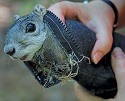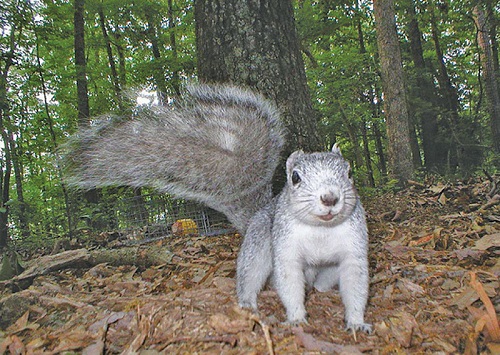 The Delmarva Peninsula fox squirrel (Sciurus niger cinereus) is found only on the Delmarva Peninsula, the land between the Chesapeake Bay and Atlantic Ocean that includes Delaware, eastern Maryland and eastern Virginia. This large tree squirrel inhabits the mature forests of this agricultural landscape.
The Delmarva Peninsula fox squirrel (Sciurus niger cinereus) is found only on the Delmarva Peninsula, the land between the Chesapeake Bay and Atlantic Ocean that includes Delaware, eastern Maryland and eastern Virginia. This large tree squirrel inhabits the mature forests of this agricultural landscape.

By 1967, the Delmarva fox squirrel, as it is more commonly known, inhabited only 10 percent of the Delmarva Peninsula and was placed on the very first endangered species list. Its distribution at that time was restricted to three counties with a small historic translocated population in a fourth county.
The squirrel’s decline in the mid-1900s was fueled by many factors. Forests were cleared for farms and development, and timber was harvested on short rotations to supply pulp for paper markets, which kept much of the forest in stands too young to provide habitat for this squirrel. The overhunting of Delmarva fox squirrels may have also played a role in its decline.
After the squirrel was listed, recovery efforts focused on expanding the range through translocations, and today there are 11 new translocated populations that continue to thrive. In addition, new populations have been discovered that were not part of the translocations. The newly discovered populations and translocations have resulted in an expanded distribution that now covers 28 percent of the Delmarva Peninsula.
The Delmarva fox squirrel can grow to 30 inches (with half of that being the tail) and weigh 1–3 pounds. The squirrel’s coat is typically a uniform silver-gray color but can vary to almost black. The only other tree squirrel on the Delmarva Peninsula is the common gray squirrel (Sciurus carolinensis). The gray squirrel is smaller (16–20 inches), has a narrower tail, brownish gray fur and is often seen in urban and suburban settings.
Although the Delmarva fox squirrel is a tree squirrel, it spends considerable time on the ground foraging for food. Less agile than the gray squirrel, the Delmarva fox squirrel ambles along the forest floor more than leaping from branch to branch. They are also quieter than the common gray squirrel.
The Delmarva fox squirrel occurs in mature forests of mixed hardwoods and pines with a closed canopy and open understory. The large trees provide abundant crops of acorns and seeds for food, and cavities for den sites. The squirrels eat a variety of foods such as acorns, walnuts, maple flowers, pine cones and fungi as well as crops from nearby fields. In the spring, females have litters that range from one to six young (The average is four.) in tree cavities or sometimes in nests of leaves.
A major focus of the recovery effort has been to increase the population size and distribution of this species by re-establishing populations within the animal’s historic range. After a study of the historic distribution, 16 reintroductions were made in Maryland, Delaware, Virginia and Pennsylvania. Eleven of these reintroductions have succeeded 15 to 20 years after their establishment with evidence of growth and expansion — a high success rate for an endangered species.

The expanded range is also the result of discovering Delmarva fox squirrels in areas where they were previously unknown. Thus, their distribution has increased because of natural expansion and reintroductions. At present, the Delmarva fox squirrel occurs in eight counties on Maryland’s Eastern Shore, Sussex County in Delaware and Accomack County in Virginia (Chincoteague National Wildlife Refuge).
The presence of Delmarva fox squirrels in a woodlot is not erratic as they tend to be present for long periods of time. They also can tolerate small timber harvests fairly well if there is an adjacent mature forest. They can use forests with a wide variety of tree species, as long as the forest is mature.
Monitoring changes in the population of this quiet, reclusive animal is challenging, so several techniques have been used. Trapping and marking live animals has been conducted for many years at several sites on national wildlife refuges. Cameras placed in the woods detect the presence of Delmarva fox squirrels faster and easier than trapping with less stress to the animal. Cameras are generally used to determine the presence or absence in a particular woodlot.
The total range of this animal is understood from mapping the sightings of Delmarva fox squirrels made by many observers across the landscape. It is often seen by deer hunters, farmers and other observers who live and work on the landscape.
The Delmarva fox squirrel is now found in 10 counties across 28 percent of the Delmarva Peninsula, and the total population is estimated to be about 20,000 animals. A recent analysis of its status and potential threats found that the overall abundance and rangewide distribution of the species makes it resilient to losses that might occur from development, sea level rise or other threats. In addition, there are many existing state laws and programs that protect habitat for the squirrel.
This analysis concluded that the squirrel is no longer at risk of extinction and recommended removing it from the list of endangered and threatened species. The U.S. Fish and Wildlife Service completed this proposal process, including addressing comments from the public, and announced in November 2015 that the squirrel would be officially removed from the endangered species list.
To see a Delmarva fox squirrel and learn about this unique resident of the Delmarva Peninsula, visit any of these national wildlife refuges: Blackwater, Dorchester County, MD; Chincoteague, Accomack County, VA; and Prime Hook, Sussex County, DE. Also be on the lookout in the woods and field edges throughout its range.
